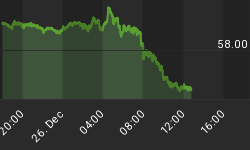The S&P had an impressive move up off the lows yesterday...however, as the Elliott Wave counts will suggest, market action subsequent to the bounce over the coming few days is important for validating either the bullish or bearish scenario.
The CBOE Options Equity Put/Call Ratio Index is shown below, with the S&P 500 Index in the background and accompanying full stochastics shown below. For this chart, the %K rising above the %D indicates broad stock market weakness, while falling beneath the %D indicates broad stock market strength. At present, the %K is above the %D, indicating broad market weakness.
Figure 1
![]() Larger Image
Larger Image
The daily chart of the S&P 500 Index is shown below with the upper 21 and 34 MA Bollinger bands in close proximity an the lower 21 MA BB beneath the 34 MA BB. Having the lower 21 MA BB beneath the lower 34 MA BB generally is a sign of a short-term oversold condition, but given current market weakness, a sharp move down would negate this and signal extreme weakness. Full stochastics 1, 2 and 3 are shown below in order of descent, with stochastics 1 and 3 having the %K above the %D. With stochastic 2 having the %K beneath the %D, as per Bollinger band analysis, a mid-term stochastic setting out of phase with the shorter and longer term generally indicates a short-term oversold condition. Anyone going long, play with cards close to your chest...any sign of a market decline beneath 805 is an indication to go to cash.
Figure 2
![]() Larger Image
Larger Image
The weekly chart of the S&P 500 Index is shown below, with lower 34 and 55 week MA Bollinger bands still declining beneath last weeks values (654 and 644 versus 666 and 665, respectively). Upper Bollinger bands are still declining, indicating the sharp decline from the back half of 2008 is far from over. Full stochastics 1, 2 and 3 are shown below in order of descent, with the %K marginally above the %D in stochastic #1. All three stochastics are at extremely oversold conditions and could become more oversold. In order for stochastic 1 to curl up and indicate the potential for a 1-2 month rally, all of the ducks on the daily chart must line up first.
Figure 3
![]() Larger Image
Larger Image
The monthly chart of the S&P 500 Index is shown below, with all lower Bollinger bands riding beneath the index, supportive of the S&P 500 Index declining for most of 2009. Note that the S&P fell below the 50, 155 and 200 month moving averages since 1990....this does not portend well for most of 2009. Full stochastics 1, 2 and 3 are shown below in order of descent, with the %K beneath the %D in all three instances. Based upon this chart, a firm market bottom is not likely due for 12-18 months from now.
Figure 4
![]() Larger Image
Larger Image
The short-term Elliott Wave count of the S&P 500 Index is shown below, with the preferred count shown in colour and the alternate count shown in grey. Based upon the preferred count, wave XX completed an expanding triangle which suggests that wave Z should be a very grinding pattern over the course of the next 4-6 weeks, with a price range between 810 and 875. If the S&P rises to 860-870 over the course of the next 3-5 days, it is possible that wave (b) of a flat may be forming. If the 805 level EVER becomes pierced over the next 5-10 trading days, it would indicate the recent decline was wave part of wave (Y), which would have a severe decline sequence lasting until the S&P bottoms around 450-550. For the preferred count to remain valid, the S&P should follow the green lines or a similar sort of pattern and simply grind sideways into mid February before rising.
Figure 5
![]() Larger Image
Larger Image
The mid-term chart of the S&P 500 Index is shown below with the preferred count shown in colour and the alternate count shown in grey. If the S&P can go sideways over the course of the next 5-10 trading days, then it is possible the path denoted in green occurs. Should the alternate count occur, a pattern similar to the one shown below could develop or it simply could cascade lower. The important level is 805...a breach of this level would negate any bullish price action and immediately cast a dark shadow upon the broad market indices.
Figure 6
![]() Larger Image
Larger Image
The long-term Elliott Wave chart of the S&P 500 Index is shown below with the preferred count shown in colour and the alternate count shown in grey. Since wave c down is likely to go to 450-550, it is highly probable that wave IV is going to form a neutral triangle i.e. wave c is the longest wave in the triangle, followed by wave d taking ½ to ¾ the time and a wave e down to end the pattern. A final end to the pattern is not due until 2012/2013.
Figure 7
![]() Larger Image
Larger Image
That is all for today...I will update the US Dollar Index tomorrow AM. Have a great day.
















